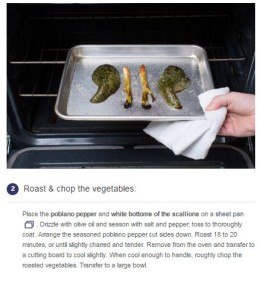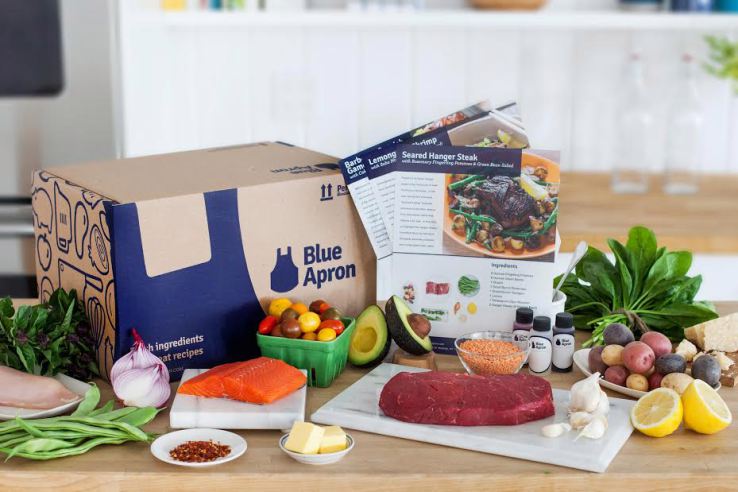Blue Apron: Fixing the Food Delivery Supply Chain
Blue Apron leverages supply chain innovation to get fresh ingredients, great recipes delivered weekly to your home.
Blue Apron creates and captures value by solving a prescient problem facing many Americans today: they love to cook but feel they don’t have the time. Blue Apron “delivers farm fresh ingredients and original recipes so [people] can create an incredible meal any night of the week2.” The company works with local farmers to create delivery boxes of perfectly portioned dinners that minimize food waste and allow users to try new ingredients and recipes, at an affordable price of $10 per meal per person.
Blue Apron curates meal kits, boxes of ingredients and instructions for cooking exactly three dinners a week. They are sold on a subscription basis for two or four people. As of December 2015, Blue Apron delivers 5 million meals a month, up from 500,000 just 18 months ago1.
 Blue Apron delivers value both to its customers and suppliers. For its customers, Blue Apron offers the opportunity to learn to cook delicious new recipes with seasonal ingredients at a better value than the local grocery store. As COO Matt Wadiak says, “everybody who wants to cook is our customer1”. The recipes are simple, with instructions written in a clear and direct way, complete with pictures. The business model focuses on removing the biggest obstacle to cooking – deciding what to cook. The service is convenient, offering free delivery in refrigerated boxes whenever best fits the customer’s schedule. The step-by-step recipes are appropriate for beginner and experienced cooks alike. The menus, which change weekly based on seasonal needs, are created by the culinary team and renowned guest chefs. For its suppliers, Blue Apron works with family-run farmers and artisans to source the highest quality ingredients. On the recipe cards, they provide an information sheet that highlights the farms which provided the produce alongside information about how to cut and cook. Click here to view a video featuring Blue Apron’s Ghee Supplier.
Blue Apron delivers value both to its customers and suppliers. For its customers, Blue Apron offers the opportunity to learn to cook delicious new recipes with seasonal ingredients at a better value than the local grocery store. As COO Matt Wadiak says, “everybody who wants to cook is our customer1”. The recipes are simple, with instructions written in a clear and direct way, complete with pictures. The business model focuses on removing the biggest obstacle to cooking – deciding what to cook. The service is convenient, offering free delivery in refrigerated boxes whenever best fits the customer’s schedule. The step-by-step recipes are appropriate for beginner and experienced cooks alike. The menus, which change weekly based on seasonal needs, are created by the culinary team and renowned guest chefs. For its suppliers, Blue Apron works with family-run farmers and artisans to source the highest quality ingredients. On the recipe cards, they provide an information sheet that highlights the farms which provided the produce alongside information about how to cut and cook. Click here to view a video featuring Blue Apron’s Ghee Supplier.
Blue Apron aligns its operating model with its business model through:
- Control of the supply chain. Blue Apron’s model centers on delivering fresh ingredients. To maintain control of quality, the company manages its own distribution channel. The company sources farms differently for each of their three regional fulfilment centers, so the food is local and fresh and the delivery costs are low. The boxes are delivered in refrigerated boxes to maintain freshness, however, so delivery is outsourced to the cheapest partner for a given shipment.
- Bulk purchasing, portioned delivery. Blue Apron built its model on the idea of reducing food waste. At each fulfilment center, workers on assembly lines pack boxes with poultry, meat, vegetables and condiments to be delivered anywhere from 1-7 days later. Purchasing in bulk allows the company to negotiate prices with farmers, who are happy to receive a slightly lower price for a guaranteed volume. By only offering 6 recipes per week, Blue Apron can allocate the ingredients in a way that reduces food waste. Everything subscribers receive is pre-measured to the precise proportions the recipe requires, meaning less spending on unnecessary produce and less food waste.
- Data analytics. As a subscription business, Blue Apron collects data on its customers that allows for predictive modeling of demand. They built an internal suite of tools that manage the workflow of purchasing, fulfilment operations, ecommerce and order processing, shipping software, customer service software6. The software can estimate how many customers will cancel an order in any given week, for example, which allows the company to plan meals based on the expected availability and price of certain crops. Using this data helps create processes that improve operational efficiency and lower costs, supporting the $10 per meal price.
- Supporting Suppliers. There is a team at Blue Apron responsible for negotiating with farms to source ingredients, but they also work closely with farmers on crop rotation and management. This allows the company to work with farmers to plan production in a way that is more seasonal, more efficient and utilizes their resources better, all of which results in higher quality crops at lower prices for consumers. Additionally, by helping farmers to plan to rotate “heavy feeder” plants with less hungry plants like legumes, the farms use less pesticide and fertilize, resulting in healthier farms.
Blue Apron focuses on bringing their customers an easy way to cook through a high quality food delivery service that has never bene available at scale before. Key operational decisions about supply chain control, supplier relations, and use of data to drive decision making, help the company succeed in its goal of delivering fresh ingredients at a low price, helping people cook great meals any night of the week.
1 http://www.vogue.com/13375872/men-love-blue-apron/
3http://www.forbes.com/sites/alexkonrad/2015/10/14/inside-blue-apron-and-the-meal-kit-rush/
4http://www.eater.com/2015/6/26/8839791/blue-apron-review-pros-cons-environment
5http://techcrunch.com/2015/06/09/blue-apron-cooks-up-135-million-in-series-d-funding/
6http://techcrunch.com/2015/07/02/an-interview-with-blue-apron-ceo-matt-salzberg/#.cjcfzce:0VhU




Thanks for the great article! I myself is not a big fan of Blue Apron because of the amount of time it takes to cook each recipe. It is usually not as fast as they advertised. My bigger concern is the environmental effects the packaging of ingredients cause. They ship you a teaspoon of soy sauce in a plastic container. It bothers me that my convenience is causing harmful damage to the planet. I wonder if others have the same concerns and they will have to address it soon.
Really enjoyed reading about this — I must admit that when Blue Apron first came out I wasn’t very bullish on the idea and thought it appealed to a small portion of the market who wishes to have meal plans at home. However, with the growing interest of millennia’s in food, recipes and making their own dishes or entertaining others at home, the Blue Apron model seems to benefit from a very important trend.
Given the shipping costs involved, I do wonder about the margins in the business. Does Blue Apron have that much more bargaining power with farmers than restaurant chains to be able to offer you a meal at home that is shipped to you? You may argue that they save margin by not cooking the meals vs. restaurants, and I would think that even then there seems to be a lot of overhead that already goes into making these packages and recipes customer ready.
Would love to have a think/chat about the margins of the business and how it can become sustainable after its growth phase
Yasmin
With a model like this one, I wonder what the maximum market size is. Though it costs less than eating out at many restaurants, $10 per portion plus your time is still a relatively high price point for many people. I would love to know what the customer profile looks like and whether the company believes it is important to bring quality, local, home-cooked dinners to families beyond the upper middle and upper economic strata.
My other thought, given the initial novelty of something like this, is that the growth in subscriptions could be short-lived. I am curious to know what kind of attrition Blue Apron typically sees. If my experience in being part of a crop-sharing alliance is any indicator, I would suspect folks drop off pretty regularly as cooking the food that arrives starts to become less of a hobby and more of a chore.
Any thoughts on these two questions?